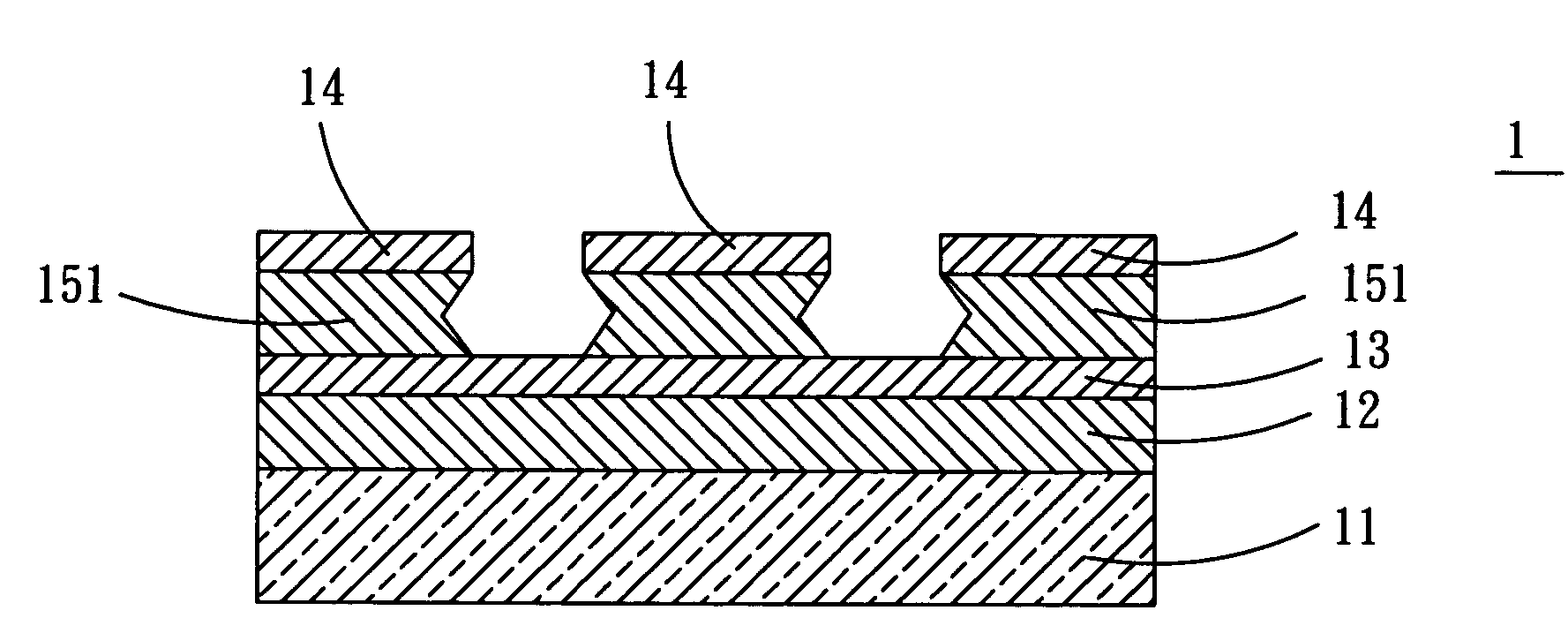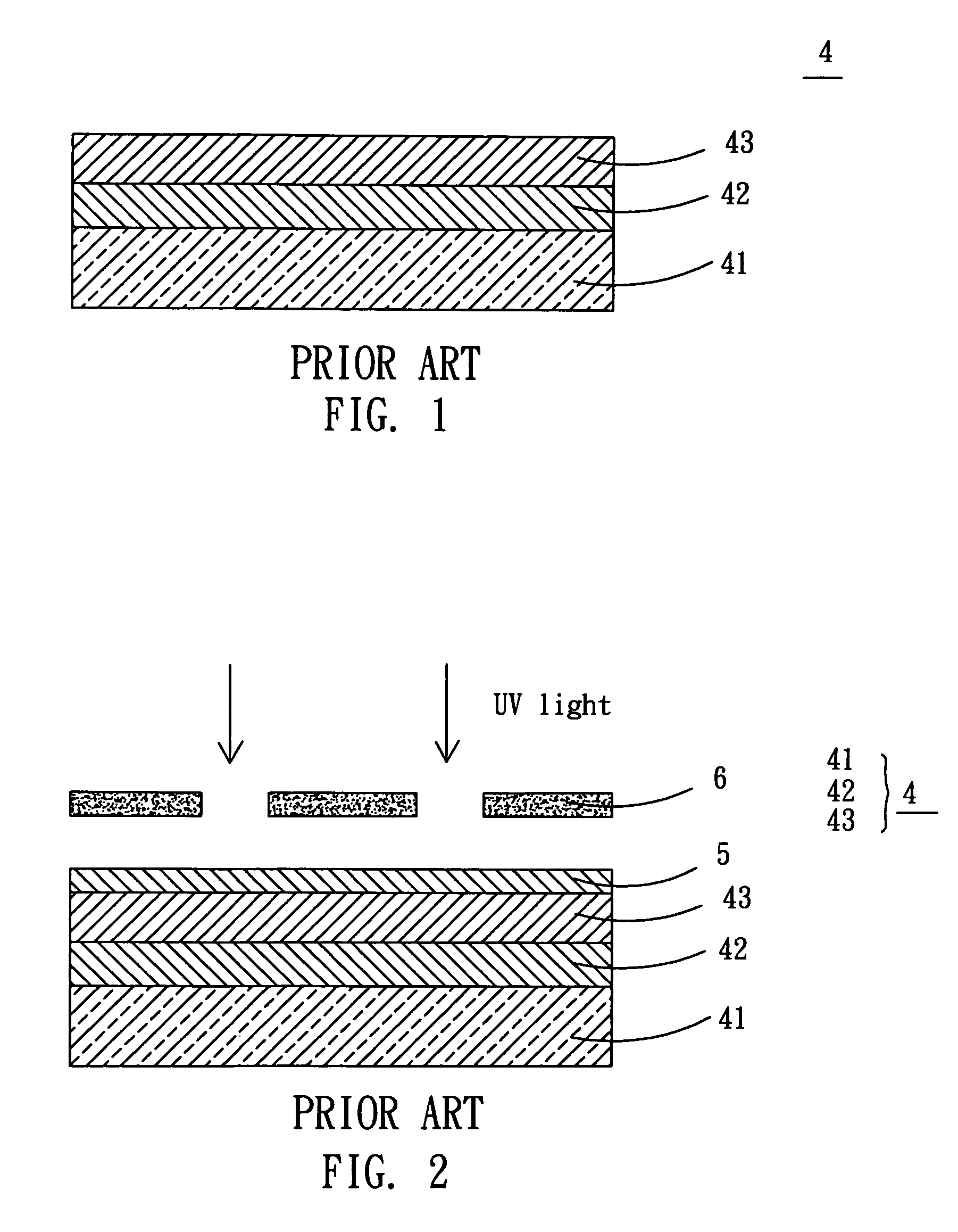Display panel, electrode panel and electrode substrate thereof
a technology of electrode substrate and substrate, which is applied in the direction of discharge tube luminescnet screen, instruments, natural mineral layered products, etc., can solve the problems of reducing the adhesion and pinhole formation reducing the adhesion of thicker metal thin films, and reducing the adhesion. , to prevent the conductive lines from being oxidized or even burnt out, the effect of enhancing the adhesion
- Summary
- Abstract
- Description
- Claims
- Application Information
AI Technical Summary
Benefits of technology
Problems solved by technology
Method used
Image
Examples
first embodiment
[0029]Referring to FIG. 3, an electrode substrate 1 of a flat panel display according to the invention comprises a substrate 11, an electrode layer 12, a first barrier layer 13, a second barrier layer 14, and a conductive layer 15. The electrode layer 12 is disposed on the substrate 11, the first barrier layer 13 is disposed on the electrode layer 12, the second barrier layer 14 is disposed above the first barrier layer 13, and the conductive layer 15 is disposed between the first barrier layer 13 and the second barrier layer 14.
[0030]In the present embodiment, the substrate 11 can be a flexible or a rigid substrate. The substrate 11 can also be a plastic or glass substrate. In particular, the flexible substrate or plastic substrate can be made of polycarbonate (PC), polyester (PET), cyclic olefin copolymer (COC), or metallocene-based cyclic olefin copolymer (mCOC).
[0031]Referring to FIG. 3, the electrode layer 12 is disposed on the substrate 11. In this embodiment, the electrode la...
second embodiment
[0042]Referring to FIG. 5, an electrode panel 2 of a flat panel display according to the invention comprises a substrate 21, an electrode layer pattern 22, a first barrier layer pattern 23, a second barrier layer pattern 24, and a conductive line pattern 25. In this embodiment, the electrode layer pattern 22 is disposed on the substrate 21 and has a plurality of electrode lines 221. The first barrier layer pattern 23 is disposed on the electrode layer pattern 22, and the second barrier layer pattern 24 is disposed above the first barrier layer pattern 23. The conductive line pattern 25 is disposed between the first barrier layer pattern 23 and the second barrier layer pattern 24. The conductive line pattern 25 has at least one conductive line 231.
[0043]In this embodiment, the electrode lines 221 of the electrode layer pattern 22 are parallel with each other or one another.
[0044]The features and functions of the substrate 21, the electrode layer pattern 22, and the barrier layer patt...
third embodiment
[0048]Referring to FIGS. 6A and 6B, a display panel 3 of a flat panel display according to the invention comprises a substrate 31, a light-emitting region 32, a driving device 33, a first barrier layer 34, a second barrier layer 35, and a conductive line pattern 36. The light-emitting region 32 has a plurality of pixels, and each of the pixels has a first electrode 321, a second electrode 323 and a light-emitting layer 322. The first electrode 321 is disposed on the substrate 31. The second electrode 323 is disposed above the first electrode 321. The light-emitting layer 322 is disposed between the first electrode 321 and the second electrode 323. The driving device 33 drives the pixels. The first barrier layer 34 is disposed above the substrate 31. The second barrier layer 35 is disposed above the first barrier layer 34. The conductive line pattern 36 is disposed between the first barrier layer 34 and the second barrier layer 35. The conductive line pattern 36 has a plurality of co...
PUM
| Property | Measurement | Unit |
|---|---|---|
| voltage | aaaaa | aaaaa |
| conductive | aaaaa | aaaaa |
| flexible | aaaaa | aaaaa |
Abstract
Description
Claims
Application Information
 Login to View More
Login to View More - R&D
- Intellectual Property
- Life Sciences
- Materials
- Tech Scout
- Unparalleled Data Quality
- Higher Quality Content
- 60% Fewer Hallucinations
Browse by: Latest US Patents, China's latest patents, Technical Efficacy Thesaurus, Application Domain, Technology Topic, Popular Technical Reports.
© 2025 PatSnap. All rights reserved.Legal|Privacy policy|Modern Slavery Act Transparency Statement|Sitemap|About US| Contact US: help@patsnap.com



